Motorsports
How Jochen Mass helped a rookie navigate F1’s most chaotic season
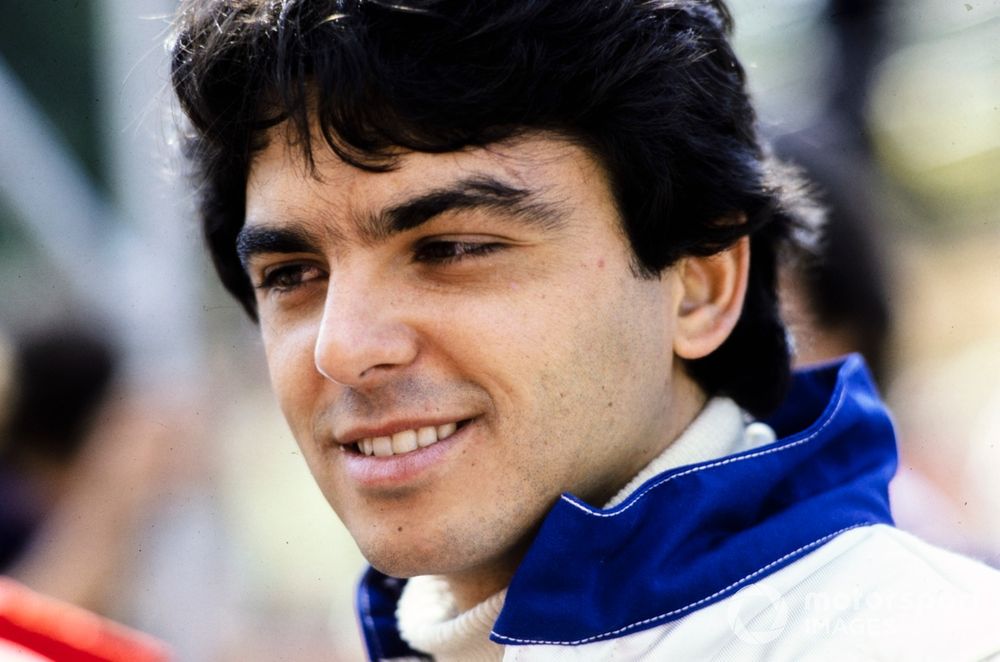
Quite apart from the unfavourable competitive situation of March Grand Prix in 1982, the year’s dizzying politics and the deaths of two fellow Formula 1 drivers made it a tough baptism for Raul Boesel. Driving the DFV-powered 821 chassis that used three different tyre suppliers during the season, the Brazilian never figured in the points. Starting 17th in Rio and finishing eighth at Zolder were the limited high points.
For Boesel, who clipped the stalled Ferrari of Didier Pironi at Montreal moments before Osella driver Riccardo Paletti fatally rammed it, there is no doubt that what was already “a difficult time” in his rookie season would have been more so without the laid-back Jochen Mass alongside him in the camp.
With any other experienced driver, Boesel anticipates that there would have been “a fight inside the team just to get the better parts” that would have made things “much harder”. But for Mass, a driver who had continued to compete in long-distance touring car and sportscar events alongside F1, the notion of a team-mate automatically being enemy number one never applied.
Boesel observes that the German “was very honest with exchanging information on the cars”, which made a huge impression. “I never forget that,” adds the driver who latterly became a stalwart of Indycar racing and finished runner-up five times in Dick Simon Racing Lolas between 1992-94.
A British Formula 3 graduate in 1982, Boesel admits to feeling star-struck when he arrived in a paddock that contained big beasts Niki Lauda, Nelson Piquet and Gilles Villeneuve. This is perhaps unsurprising given the speed of his ascent; he had been racing Formula Fords just two years beforehand, finishing runner-up in both the 1980 RAC and Townsend Thoresen championships, before placing third in British F3 aboard his Murray Taylor Ralt in 1981.
“When I arrived [in F1], I was very shy,” admits Boesel, who went on to win the World Sportscar Championship with Jaguar in 1987. “And Jochen, he opened his arms and was very good at teaching me a lot of things. He was very experienced, was very welcoming on his side on the team.”
Rookie Boesel had a baptism of fire in 1982, but welcome the generosity of team-mate Mass
Photo by: Motorsport Images

Mass was in a very different position in his career to Boesel; he had made his debut with Surtees back in 1973, and had won the red-flagged 1975 Spanish Grand Prix at Montjuic Park during a three-season stretch with McLaren. Returning to F1 after a year out in 1982, he had little to prove and was happy to assist his young team-mate, offering a preview of the mentor role he would later take on with the Mercedes junior team towards the end of the decade in Group C.
Mass was even supportive on occasions the youngster outqualified him during their 10 Grands Prix together (which would have been 11 had the RAM-run Marches and its fellow FOCA-aligned teams not boycotted the San Marino Grand Prix at the peak of the FISA-FOCA war, following the disqualification of Piquet and Keke Rosberg from the Brazilian GP).
Boesel was quicker in three of the first four races on Pirellis, before a switch to Avon for Monaco swung the needle in the direction of Mass. It was a misstep, as the British manufacturer had announced its intention to withdraw from F1; team boss John Macdonald bought up Avon’s stock, but development was non-existent.
“We had very difficult times at March but a few races that I qualified ahead of him, [Mass] was kind of happy. He would say ‘congratulations on how you did’, he was friendly all the time”
Raul Boesel
Ultimately the qualifying head-to-head stood at 5-5 following the French GP at Paul Ricard, where a scary crash with Mauro Baldi’s Arrows at Signes Curve prompted Mass – still shaken from his involvement in Villeneuve’s fatal accident at Zolder – to call time on F1 and focus exclusively on sportscars. The late Rupert Keegan replaced him for the remainder of a trying campaign which included two races on Michelins.
The 821 was the year’s 15th fastest car by a metric of supertimes, as March fell in behind Toleman, ATS, Osella, Arrows and Ensign. Only Theodore, with its revolving cast of drivers including Derek Daly, Jan Lammers, Geoff Lees and Tommy Byrne, and Fittipaldi (a one-car team for Chico Serra, who came to blows with Boesel in the Montreal pitlane) were slower than the second iteration of Macdonald’s collaboration with March Engineering – which by 1982 was effectively in name only.
Chief engineer Adrian Reynard had made the car stiffer and lighter than its predecessor, the first March-designed F1 car since 1977 which had been derided by Macdonald in public, but even an injection of funds from Rothmans couldn’t transform the normally-aspirated car’s competitive prospects as turbo power became increasingly potent. The cigarette manufacturer eventually terminated its support before the benefits could truly take effect.
“We had very difficult times at March but a few races that I qualified ahead of him, [Mass] was kind of happy in a way,” remembers Boesel. “He would say ‘congratulations on how you did’, and he was very friendly all the time. He spent many years in Formula 1 and everybody respected him, so it wasn’t much difference for him to be outqualified in a few races.”
Mass (left, with Adrian Reynard) bowed out of F1 mid-season during the tumultuous 1982
Photo by: David Phipps
That Mass was content to be his own man and collaborate with his team-mates, a trait that made him such an effective foil to Jacky Ickx in the works Rothmans Porsche Group C team, was evidenced by him not joining the drivers’ strike at Johannesburg’s Sunnyside Park Hotel on the eve of the South African Grand Prix. That he had been staying with friends and was unaware of the details was immaterial.
For Boesel, preparing for his first Grand Prix, the controversy over changes to the superlicence that would prevent drivers from changing teams was an unwelcome distraction.
“Jochen was the only one that didn’t go to the hotel,” points out Boesel, who naturally felt strong peer pressure to join his contemporaries. “I remember John Macdonald was hitting on the bus windscreen on the side where I was sitting and screaming ‘if you don’t come out of this bus, your career is finished’. On the other side of the bus, Gilles Villeneuve was saying, ‘Look, you guys have all the support from us, the more experienced drivers, we will not let this happen’.”
Mass set a standard that Boesel would not experience again during his all-too-brief F1 career, which concluded after just 23 starts following a 1983 season in which neither he nor Ligier team-mate Jean-Pierre Jarier could score in the normally-aspirated JS21. “When I went to Ligier it was very different,” he adds.
After switching to Indycar with Dick Simon for 1985-86, Boesel’s career peaked in 1987 when Mass was in the final year of his Porsche affiliation before the move to Group C rival Mercedes that finally netted him a Le Mans victory in 1989.
Five wins in TWR-run XJR-8s shared with co-drivers including Eddie Cheever, John Nielsen, Martin Brundle and Johnny Dumfries earned Boesel the title, and he was regularly brought back into the fold over the next several years in parallel with Indycar commitments, adding the Daytona 24 Hours in 1988 with Brundle and Nielsen. He also contested the full IMSA schedule in 1991 along with Davy Jones in TWR’s two-car attack.
But the 66-year-old, who saw out his career in the all-oval Indy Racing League following stints racing alongside the likes of Scott Brayton (1992-93), Bobby Rahal (1995) and Scott Pruett (1997) on the other side of ‘the split’, cannot look beyond Mass for his favourite team-mate because of the lasting impression he made in a chaotic season like no other.
“Arriving in F1 with a lot of anxiety, it was a bit easier to have somebody else like that to give you support,” concludes Boesel, who today indulges his passion for electronic music as a DJ.
Boesel later encountered his 1982 team-mate when they raced in Group C
Photo by: Motorsport Images

Motorsports
Wolff reveals tip-off from Sainz Sr over Hamilton’s Ferrari F1 move
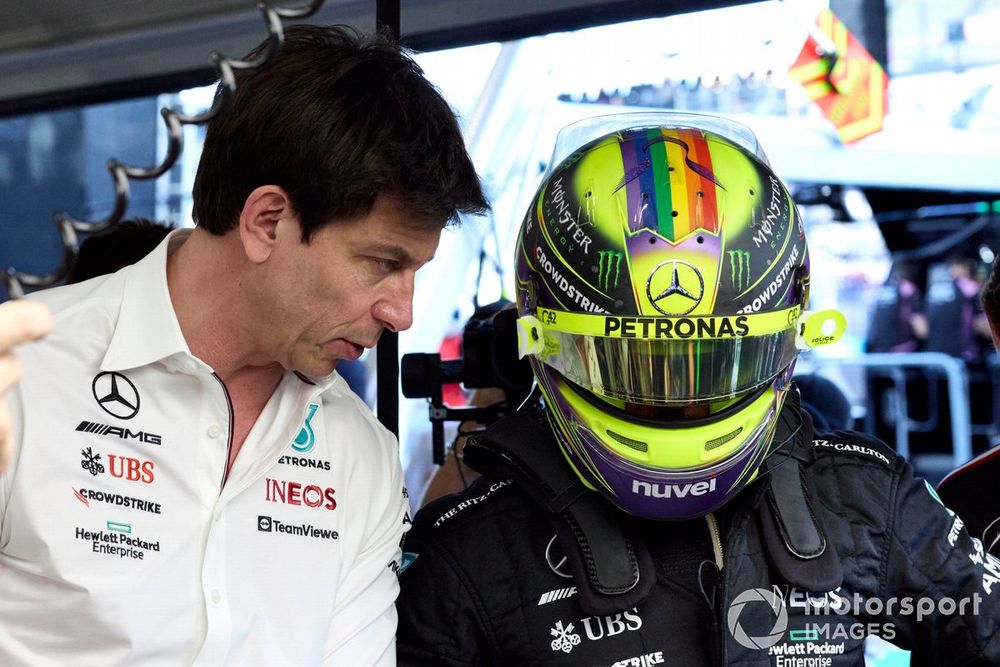
Mercedes boss Toto Wolff has opened up on details surrounding Lewis Hamilton’s shock move to Ferrari – and how he got an early tip-off from Carlos Sainz Sr.
Hamilton told Wolff during a visit to his house at the end of January that he would be activating an exit clause in his Mercedes contract and joining Ferrari for the 2025 season.
But while Hamilton’s announcement was the first official confirmation that Wolff had of his driver’s departure, he has now spoken at length about how he had been alerted to the prospect for a little while.
Speaking to the High Performance podcast, Wolff said that an initial call from Sainz Sr., father of the Ferrari driver Carlos that Hamilton is replacing, had been where he first got word that something was in the offing.
“So I heard the bells ringing two weeks before,” said Wolff. “Yeah, the old man Sainz called me and said, this is what’s happening.
“And then there were a few drivers’ dads rang me up that didn’t before. So I thought, Okay…there’s something going on there.
“And then I sent a text to [Ferrari boss] Fred Vasseur saying: ‘You’re taking our driver?’ Didn’t get any response. Very unusual for Fred. He’s a good friend. So yeah, I saw it coming.”
With his suspicion about the intention of Hamilton’s visit to his house, Wolff also revealed that he threw a curveball into their chat by first telling the seven-time champion about Mercedes having signed former Ferrari chief designer Simone Resta.

Toto Wolff, Team Principal and CEO, Mercedes-AMG, with Lewis Hamilton, Mercedes-AMG
Photo by: Steve Etherington / Motorsport Images
“When Lewis arrived in the house, like he did so many years before, we had a bit of a small talk, like we always do about the Christmas holidays and all of that,” explained Wolff.
“Then I said, “Well, we’re recruiting from Ferrari now. We got this guy.” And Lewis was, “Oh, there’s something I need to tell you.” And yeah, when he said that, that initial moment was a little bit of… so this is really happening?”
When news of Hamilton’s Ferrari decision was made public, it became one of the biggest shock news events of recent F1 history.
But Wolff said that he was able to deal with the situation in quite a calm manner.
“Well, I had much worse in my life, happening, like real drama and trauma,” he said. “This is not even moving the needle.”
He added: “It’s just a new situation. It has risks and opportunities, risks in the sense of how do I inform the sponsors as quickly as possible? Because it was leaking… And on the other side, what are we doing about next year?”
Wolff also made it clear that there was no temptation from his side to try to persuade Hamilton to change his mind.
“I think if someone decides to go, then you need to let them go,” he said. “I had a chat with Pep Guardiola a long time ago, and he is a friend. I said, ‘What do you do if this and that player leaves?’ And he said, ‘What do you mean I do?’ I said, ‘Well, do you try to convince them to stay?’
“He said: ‘No, if somebody thinks he can play elsewhere better or earns more – you have just got to let them go.’ And it is something that I embrace in the same way here. Somebody wants to go – then let’s make it as good as possible for each of the parties.”
Motorsports
Live – WSK Final Cup: Round 1 – Lonato
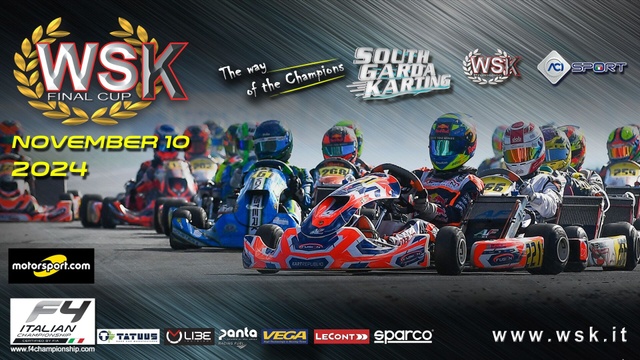
Continue reading with advertising …
… or with a subscription
Visit motorsport.com as usual with advertising and tracking. You can revoke your consent at any time via the data protection page.1
Use motorsport.com without any advertising banners, personalized tracking and commercials for a small fee.
More information about advertising and tracking in our Data protection notice, the List of our partners and in Data protection information center.
Already a subscriber?
Log in here
Motorsports
“Bagnaia is in a team built to win, we are against the world”
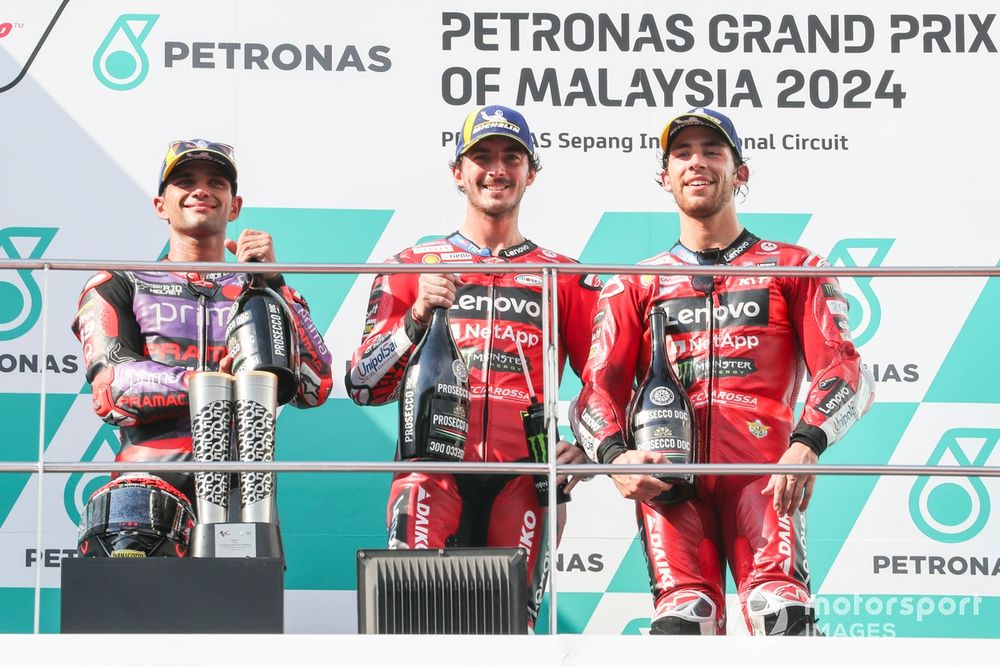
Jorge Martin feels he and Pramac have been fighting “against the world” in MotoGP this year, with his rival Francesco Bagnaia racing for a factory Ducati team that is “built to win”.
Martin is on the verge of winning the MotoGP world title having carved out a 24-point lead with just 37 on offer in next week’s Barcelona season finale.
Satellite teams have traditionally been at a massive disadvantage with respect to factory squads in the past, but Ducati has overhauled the way bike manufacturers compete in MotoGP in the last few years by forging a closer relationship with teams it supplies bikes to.
As part of its new methodology, Martin is contracted directly to Ducati and rides the same specification of GP24 as Bagnaia and Enea Bastianini in the factory team, thus offering him parity of equipment.
However, while the lines between satellite and factory teams have become blurred in recent years, Pramac remains an independent outfit and doesn’t have the same resources as that of a manufacturer.
It’s why the significance of winning a title against a factory rider is not lost on Martin, who could wrap up the championship as early as the sprint race in Barcelona.
“He’s in a different moment, he’s been in MotoGP for six years, he’s in an official team, he has everything, his environment, ready to win,” said the Spaniard.
“I have a team of 12 people who fight alone against the world, and with that to achieve what we have achieved, seven sprint [wins], three victories and 30 podiums [15 in races and another 15 in sprints], I can’t ask for more.
“[The success] is not because of me, it’s because of my people, my environment, my team, all the people around me, I just want to achieve it for them, so that they can enjoy it, that’s what fills me [with joy] and excites me.”
Francesco Bagnaia, Ducati Team, Jorge Martin, Pramac Racing
Photo by: Gold and Goose / Motorsport Images

Bagnaia has established himself as one of the best riders of the generation after winning back-to-back titles in 2022 and ’23 with Ducati.
The Italian has put up a strong fight against Martin this year, winning 10 of the 19 grands prix so far and scoring six further victories in the sprints.
Martin stressed that winning the 2024 title would carry extra value just because he would have defeated an in-form – if error-prone – Bagnaia to the crown.
“It is a pride to reach this point of the season fighting for the championship,” he said. “It’s a pride to have a rival like Bagnaia, because this makes me better.
“That Pecco is at his highest level and being able to fight with him, to be able to push him to the limit, makes what we are both doing more valuable.
“I’ve won seven times this year, true, but it will be very difficult in the last grand prix to beat a Pecco in the form he is in now.
“We’ll see how the weekend develops, it will be in colder conditions, which usually suits me better. With a lot of heat it’s a perfect condition for Bagnaia. There will be more chances of failing in lower temperatures, but the risk will be the same for both of us.
“It’s always difficult to play for a title in the last event, anything can happen. But I arrive confident and believing that I can achieve it.”
Motorsports
F1 2026 rule tweaks will open door for “different concepts”
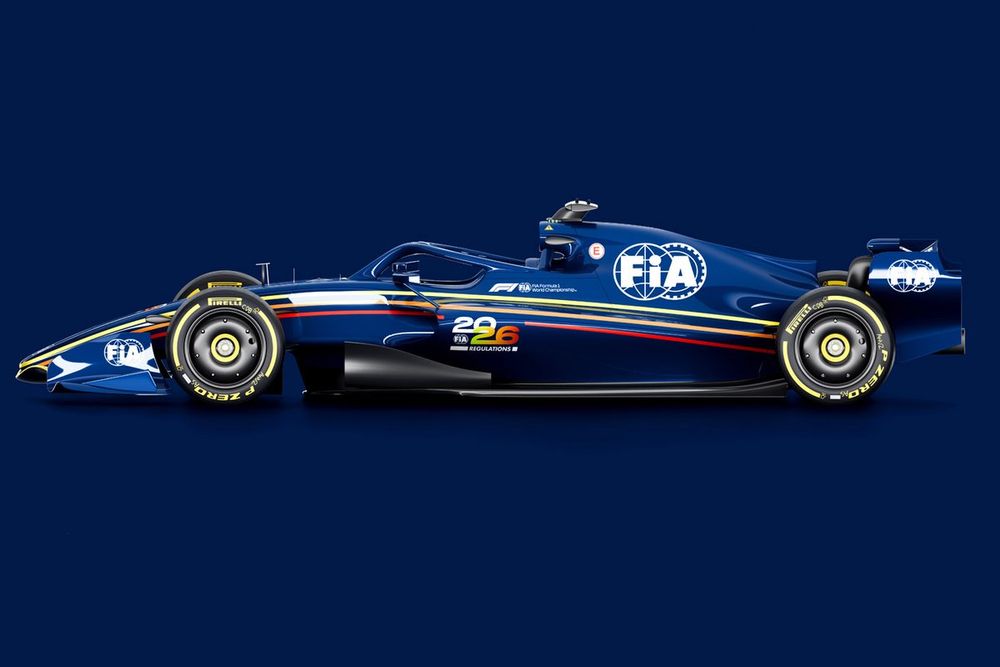
The recent changes to Formula 1’s technical regulations for 2026 will give teams more freedom to explore different design concepts, says Williams chief James Vowles.
Recently, the rules prescribing F1’s new car designs for 2026 have been tweaked following concerns that the new generation of cars would be too slow.
The new cars, which will be paired to overhauled engine regulations with a bigger reliance on electric energy, will have significantly less drag and wake turbulence to improve the racing, but the latest version of the rules has increased the amount of downforce they will generate to bring cornering speeds closer to current levels.
The FIA relaxed limitations around the front wing area and the front floor, with scope to add bargeboards, and the size of the diffuser has been increased compared to the draft that was presented to teams in June and received mixed reviews.
The changes were welcomed by the teams, not just because of the increase in performance but because there will now be more freedom for designers to explore different concepts. That could lead to cars that are visibly much more different across the grid compared to the current generation of ground-effect-based machinery, where teams soon converged on very similar concepts.
“We now have more freedom where you could see a different direction that you’re going in,” Vowles said. “So there’s more flow controlling devices in place, which lead to downforce, but differentiation between teams. What’s been really positive as well is there’s still some small areas of improvement around the diffuser.
“What’s great to see is teams in F1 working hand-in-hand in order to improve that, because every time you make a change like that, it has some consequences.
“I think what you’re going to see now is instead of all teams working in the same few millimetres, there’ll be some different concepts. I personally think that is good for the sport.”

F1 2026 FIA car renders
Photo by: FIA
Vowles’ McLaren counterpart Andrea Stella also felt giving engineers more freedom will lead to a bigger spread of designs.
“With the recent release of the car geometry, especially from an aerodynamic point of view, basically two main things have been achieved,” he explained. “One is a much higher downforce level, and the second one is more freedom. We welcome both.
“We welcome more freedom. I think this will give teams the possibility to just use their knowledge, use their methodologies. The knowledge that has been accrued over the years, even if with different regulations, is a way of creating some differentiation.
“So, we’ve always been advocating this kind of approach and we welcome the fact that there will be more freedom.”
Motorsports
America needs a competitive F1 driver — Jak Crawford could be the answer
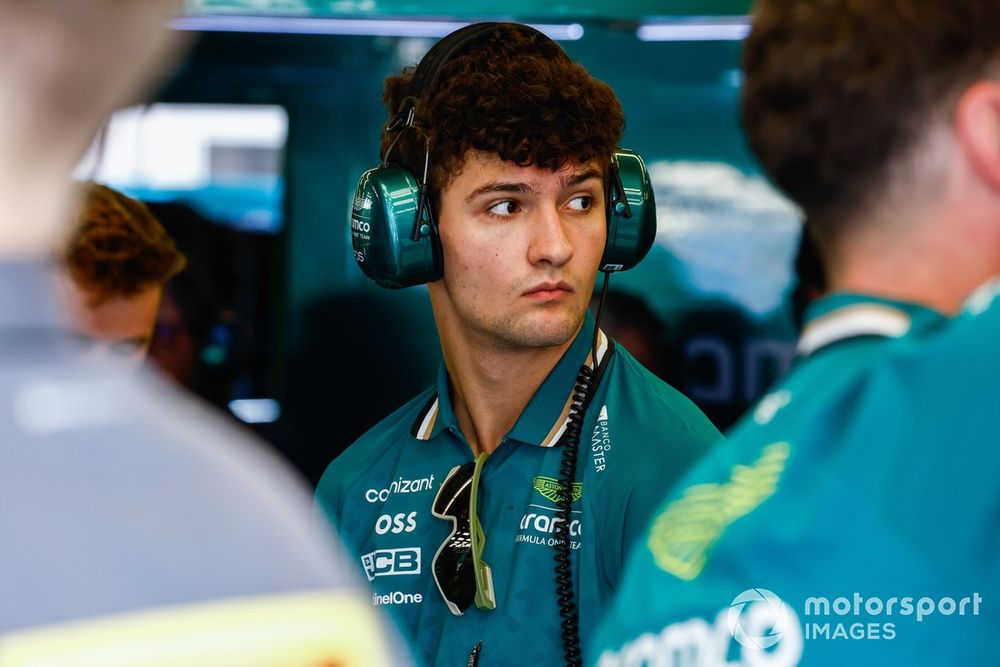
Formula 1 has had a shaky relationship with American drivers. Despite Liberty Media’s extensive efforts to capture the $69 billion US sports market, the historically Euro-centric sport hasn’t produced a competitive American driver this century. Jak Crawford, the highest ranked American in the pipeline to F1, hopes he can change that.
The 19-year-old, raised on the go-kart tracks of Texas, has secured two wins and 10 podiums throughout his Formula 2 career, currently racing for DAMS Lucas Oil. “It’s crazy to think I’m the closest American to F1,” Crawford told Motorsport.
“Americans want to see a driver who’s winning and doing really well for their country, so that’s my goal. I have a great opportunity to become the American driver [if] I’m able to do it.”
Crawford is currently fifth place in the F2 standings — ahead of Kimi Antonelli and Ollie Bearman who are bound for F1 seats with Mercedes and Haas, respectively, next season. “Being ahead of them in the championship gives me confidence and reassurance that I could do that too if I get the chance,” he said. Crawford had also surpassed Argentina’s Franco Colapinto in F2 standings, who was called up to F1 by Williams over the summer. “I’m looking forward to getting that chance one day to show what I can do,” he added confidently.
There’s a myriad of factors that have led to the 46-year drought since an American last stood on the top step of an F1 podium (Mario Andretti claimed victory at the 1978 Dutch Grand Prix). Above all, the ladder to F1 is virtually impossible to climb without relocating to Europe as a teenager.
Crawford, for his part, moved to England by himself at 14 to follow the well-worn European developmental path. “It was eye-opening for sure. You don’t realize how much you don’t know until you’re asking your mom how to work the dishwasher,” the softly-spoken Texan said with a laugh. Signing a five-year deal with the Red Bull Driver Academy in 2019, he secured a fully-financed seat in Formula 4. Before that, his karting career was funded by his dad, Tim, who thought the youngster was destined for a career in NASCAR. That was until Helmut Marko, godfather of the illustrious junior program, offered Crawford a life-changing contract.
“It was great at the beginning. The academy gave me a great path and helped me chase my dreams, especially when I started in F4,” he reflected. However, the relationship “fizzled out” over the years, many of which were fraught by the COVID-19 pandemic and fierce competition within the academy.
Graduates of the notoriously cut-throat program, including Max Verstappen and Daniel Ricciardo, have spoken about the pressures placed on them by Marko. Crawford said he was given only one directive by the famed talent spotter: “win the championship.”
“I realised there was no path for me into a race seat [with Red Bull],” Crawford explained. “There were too many guys – a lot of really good ones – so I figured it was best that I left.” He went on to join the Aston Martin Development Program, where he’s eyeing a 2025 reserve role with the team and, if all goes to plan, a 2026 race seat.
Crawford has already started learning from veterans of the sport within Aston Martin. “I’ve been able to learn so much from Fernando [Alonso], mainly off-track, just listening to him in engineering meetings,” he said of the two-time World Champion. “It’s great to hear what he and Lance [Stroll] say about the car and the language they use because I’m able to apply that to my work with my [F2] team.”
Jak Crawford, Development Driver, Aston Martin F1 Team
Photo by: Zak Mauger / Motorsport Images

F1’s explosion in popularity in the early 2020s has shone a spotlight on the young drivers in the sport’s development series, who were once largely unknown outside of hardcore motorsport circles.
“It’s grown massively, especially with people my age,” Crawford said, referencing the significantly younger demographic who are not only tuning into races, but also engaging with content on social media. “As I’ve gotten closer to the top, I’ve started getting more followers and likes,” he went on, noting his 57,000-strong Instagram following has allowed him to grow his personal brand.
He’s also acutely aware that his country is eager to see one of their own succeed at the pinnacle of racing. However, Liberty Media’s fervent pursuit of American fandom [read: American dollars] doesn’t mean Americans have been fully embraced within the paddock just yet. Michael Andretti’s bid to join the grid was rejected by the sport’s management arm earlier this year, sparking an antitrust investigation by the U.S. Department of Justice. Meanwhile, Florida native Logan Sargeant was unceremoniously dumped by Williams mid-season, bringing the American’s F1 career to an abrupt end.
With the sport booming, there has never been a stronger financial incentive to invest in an American driver. Williams took that gamble with Sargeant, but inconsistent results and a spate of costly crashes may have left teams wary about hiring an American without strong performances to back up their marketability.
Crawford is focused on proving that a U.S. driver can thrive in the sport, though the path to success remains steep. His next step is a postseason test in Abu Dhabi, where he’ll get behind the wheel of the AMR24. “It’s a great opportunity,” he said. “I’ve driven the 2022 car so I already know all of the buttons, which is the most difficult part.” It’s clear Crawford could be on the brink of a breakthrough, and should the stars continue aligning, American fans may have a new countryman to cheer for.
Motorsports
The key change that has helped Magnussen finally click with his Haas
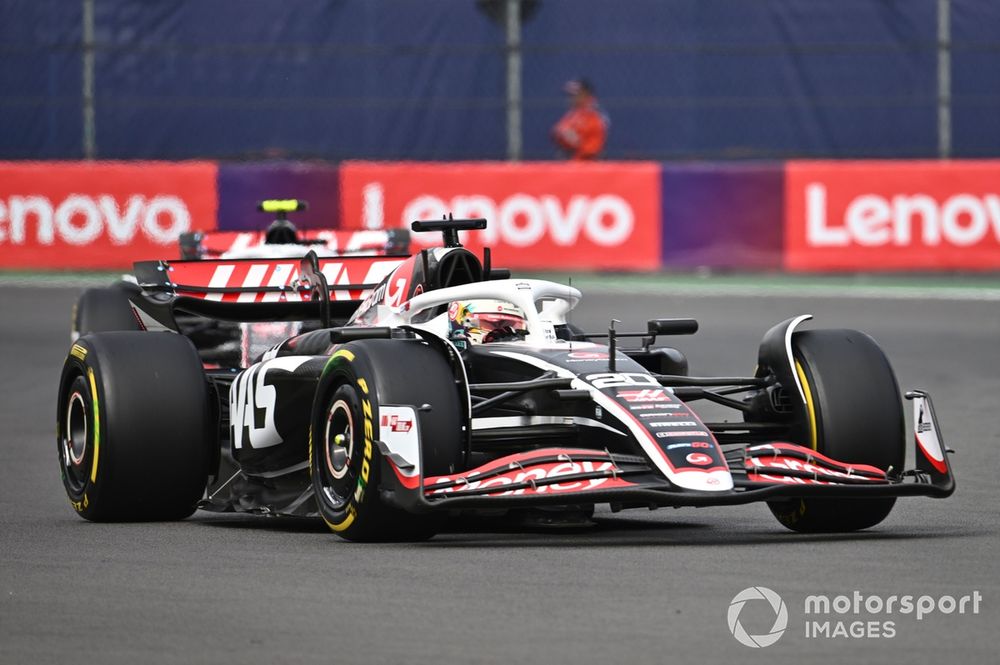
Kevin Magnussen’s pace has been transformed recently, with Mexico seeing him produce his best qualifying and Formula 1 race result of the season.
Critically, that showing was not the result of some freak circumstance, as it came from some pretty impressive pace that even meant he was faster than Red Bull’s Max Verstappen in the closing stages of the race.
It is a far cry from the start of the season when Magnussen was struggling to get confident in Haas’s 2024 challenger, and earned attention more for his rear gunner tactics than his hard results out on track.
The breakthrough that he appears to have made since Austin, which could prove critical in Haas’s constructors’ championship battle with RB, has come at the same time as the team introduced a major new upgrade – but it is not those aero parts that have made the difference.
Instead, key to Magnussen finally unleashing the pace that he knew he had within him is increased confidence on corner entry, and especially when it comes to brake feel.
“This year it’s been very inconsistent on the brakes and I feel like we hopefully fixed that,” said Magnussen, when asked by Motorsport.com to explain where his step forward had come from.
“It certainly seemed that way in the last two races that there was a change that was made which I really felt. That was very positive.
“Hopefully it’s not temperature-related and hopefully it is real, but it certainly coincided with making that change.”

Kevin Magnussen, Haas VF-24, Nico Hulkenberg, Haas VF-24
Photo by: Simon Galloway / Motorsport Images
Digging a bit deeper into the specifics of where things are better, Magnussen explained that it was all related to that initial braking phase.
“This season, when I hit the brakes, they sort of have a bit of lag and then they bite a little while after hitting the brakes,” he said.
“So it’s that initial feeling that I hit the brakes very hard. My peak brake pressure is always way higher than Nico [Hulkenberg], and so I think I just need to feel the brakes switch on immediately, and that’s been really hurting my confidence on entries.
“It upsets you in a bad way when you already feel uncomfortable with the brakes. So that’s been a big help.
“To know that they bite on the same way every time you hit the brakes, that’s a big thing for me.”
Haas is currently 10 points ahead of RB in the fight for sixth in the constructors’ championship, having had a run of five top-10 finishes.
And although it seems to have a decent pace advantage over its Faenza-based rival, Magnussen says it cannot take anything for granted just yet.
“We’re happy that we’re 10 points ahead, but I don’t think you can ever be too confident here,” he said.
“It can swing around very quickly. They just need one good race and they’re equal with us again. So we just need to stay on the ball.”
-

 Science & Environment2 months ago
Science & Environment2 months agoHow to unsnarl a tangle of threads, according to physics
-

 Technology1 month ago
Technology1 month agoIs sharing your smartphone PIN part of a healthy relationship?
-

 Science & Environment2 months ago
Science & Environment2 months agoHyperelastic gel is one of the stretchiest materials known to science
-

 Science & Environment2 months ago
Science & Environment2 months ago‘Running of the bulls’ festival crowds move like charged particles
-

 Technology2 months ago
Technology2 months agoWould-be reality TV contestants ‘not looking real’
-

 Science & Environment1 month ago
Science & Environment1 month agoX-rays reveal half-billion-year-old insect ancestor
-

 Sport1 month ago
Sport1 month agoAaron Ramsdale: Southampton goalkeeper left Arsenal for more game time
-

 Money1 month ago
Money1 month agoWetherspoons issues update on closures – see the full list of five still at risk and 26 gone for good
-

 Science & Environment2 months ago
Science & Environment2 months agoPhysicists have worked out how to melt any material
-

 MMA1 month ago
MMA1 month ago‘Dirt decision’: Conor McGregor, pros react to Jose Aldo’s razor-thin loss at UFC 307
-

 Science & Environment2 months ago
Science & Environment2 months agoMaxwell’s demon charges quantum batteries inside of a quantum computer
-

 Football1 month ago
Football1 month agoRangers & Celtic ready for first SWPL derby showdown
-

 Science & Environment2 months ago
Science & Environment2 months agoSunlight-trapping device can generate temperatures over 1000°C
-

 Science & Environment2 months ago
Science & Environment2 months agoLaser helps turn an electron into a coil of mass and charge
-

 News1 month ago
News1 month agoWoman who died of cancer ‘was misdiagnosed on phone call with GP’
-
Business1 month ago
how UniCredit built its Commerzbank stake
-

 News1 month ago
News1 month ago‘Blacks for Trump’ and Pennsylvania progressives play for undecided voters
-

 Science & Environment2 months ago
Science & Environment2 months agoA new kind of experiment at the Large Hadron Collider could unravel quantum reality
-

 Science & Environment2 months ago
Science & Environment2 months agoLiquid crystals could improve quantum communication devices
-

 Technology1 month ago
Technology1 month agoUkraine is using AI to manage the removal of Russian landmines
-

 Technology1 month ago
Technology1 month agoGmail gets redesigned summary cards with more data & features
-

 Technology1 month ago
Technology1 month agoSamsung Passkeys will work with Samsung’s smart home devices
-

 Science & Environment2 months ago
Science & Environment2 months agoWhy this is a golden age for life to thrive across the universe
-

 Sport1 month ago
Sport1 month agoBoxing: World champion Nick Ball set for Liverpool homecoming against Ronny Rios
-

 Technology1 month ago
Technology1 month agoEpic Games CEO Tim Sweeney renews blast at ‘gatekeeper’ platform owners
-

 Sport1 month ago
Sport1 month ago2024 ICC Women’s T20 World Cup: Pakistan beat Sri Lanka
-

 Science & Environment2 months ago
Science & Environment2 months agoQuantum ‘supersolid’ matter stirred using magnets
-

 Technology1 month ago
Technology1 month agoRussia is building ground-based kamikaze robots out of old hoverboards
-

 News1 month ago
News1 month agoMassive blasts in Beirut after renewed Israeli air strikes
-

 Entertainment1 month ago
Entertainment1 month agoBruce Springsteen endorses Harris, calls Trump “most dangerous candidate for president in my lifetime”
-

 MMA1 month ago
MMA1 month agoDana White’s Contender Series 74 recap, analysis, winner grades
-

 News1 month ago
News1 month agoNavigating the News Void: Opportunities for Revitalization
-

 Technology1 month ago
Technology1 month agoMicrosoft just dropped Drasi, and it could change how we handle big data
-

 MMA1 month ago
MMA1 month agoPereira vs. Rountree prediction: Champ chases legend status
-

 MMA1 month ago
MMA1 month ago‘Uncrowned queen’ Kayla Harrison tastes blood, wants UFC title run
-

 Technology1 month ago
Technology1 month agoMicrophone made of atom-thick graphene could be used in smartphones
-
Business1 month ago
Top shale boss says US ‘unusually vulnerable’ to Middle East oil shock
-

 Technology1 month ago
Technology1 month agoSingleStore’s BryteFlow acquisition targets data integration
-

 Technology1 month ago
Technology1 month agoCheck, Remote, and Gusto discuss the future of work at Disrupt 2024
-

 Sport1 month ago
Sport1 month agoWXV1: Canada 21-8 Ireland – Hosts make it two wins from two
-

 News1 month ago
News1 month agoRwanda restricts funeral sizes following outbreak
-

 Business1 month ago
Business1 month agoWater companies ‘failing to address customers’ concerns’
-

 TV1 month ago
TV1 month agoসারাদেশে দিনব্যাপী বৃষ্টির পূর্বাভাস; সমুদ্রবন্দরে ৩ নম্বর সংকেত | Weather Today | Jamuna TV
-

 Science & Environment2 months ago
Science & Environment2 months agoQuantum forces used to automatically assemble tiny device
-

 Technology1 month ago
Technology1 month agoWhy Machines Learn: A clever primer makes sense of what makes AI possible
-

 News2 months ago
News2 months ago▶️ Hamas in the West Bank: Rising Support and Deadly Attacks You Might Not Know About
-

 Technology2 months ago
Technology2 months agoMeta has a major opportunity to win the AI hardware race
-

 News1 month ago
News1 month agoCornell is about to deport a student over Palestine activism
-

 Business1 month ago
Business1 month agoWhen to tip and when not to tip
-

 MMA1 month ago
MMA1 month agoKayla Harrison gets involved in nasty war of words with Julianna Pena and Ketlen Vieira
-

 News1 month ago
News1 month agoHull KR 10-8 Warrington Wolves – Robins reach first Super League Grand Final
-

 Science & Environment2 months ago
Science & Environment2 months agoITER: Is the world’s biggest fusion experiment dead after new delay to 2035?
-

 Science & Environment2 months ago
Science & Environment2 months agoNuclear fusion experiment overcomes two key operating hurdles
-

 Football1 month ago
Football1 month ago'Rangers outclassed and outplayed as Hearts stop rot'
-

 MMA1 month ago
MMA1 month agoPennington vs. Peña pick: Can ex-champ recapture title?
-

 Technology1 month ago
Technology1 month agoLG C4 OLED smart TVs hit record-low prices ahead of Prime Day
-
Travel1 month ago
World of Hyatt welcomes iconic lifestyle brand in latest partnership
-

 Sport1 month ago
Sport1 month agoShanghai Masters: Jannik Sinner and Carlos Alcaraz win openers
-

 Science & Environment2 months ago
Science & Environment2 months agoA slight curve helps rocks make the biggest splash
-

 Technology1 month ago
Technology1 month agoUniversity examiners fail to spot ChatGPT answers in real-world test
-

 Sport1 month ago
Sport1 month agoPremiership Women’s Rugby: Exeter Chiefs boss unhappy with WXV clash
-

 News1 month ago
News1 month ago▶ Hamas Spent $1B on Tunnels Instead of Investing in a Future for Gaza’s People
-

 Sport1 month ago
Sport1 month agoChina Open: Carlos Alcaraz recovers to beat Jannik Sinner in dramatic final
-

 Football1 month ago
Football1 month agoWhy does Prince William support Aston Villa?
-

 Money1 month ago
Money1 month agoTiny clue on edge of £1 coin that makes it worth 2500 times its face value – do you have one lurking in your change?
-

 Science & Environment2 months ago
Science & Environment2 months agoNerve fibres in the brain could generate quantum entanglement
-

 Womens Workouts2 months ago
Womens Workouts2 months ago3 Day Full Body Women’s Dumbbell Only Workout
-

 Technology1 month ago
Technology1 month agoMusk faces SEC questions over X takeover
-

 Sport1 month ago
Sport1 month agoSturm Graz: How Austrians ended Red Bull’s title dominance
-

 Sport1 month ago
Sport1 month agoURC: Munster 23-0 Ospreys – hosts enjoy second win of season
-

 Sport1 month ago
Sport1 month agoCoco Gauff stages superb comeback to reach China Open final
-
Business1 month ago
Bank of England warns of ‘future stress’ from hedge fund bets against US Treasuries
-

 Technology1 month ago
Technology1 month agoQuoroom acquires Investory to scale up its capital-raising platform for startups
-
Business1 month ago
Italy seeks to raise more windfall taxes from companies
-

 MMA1 month ago
MMA1 month ago‘I was fighting on automatic pilot’ at UFC 306
-

 MMA1 month ago
MMA1 month agoHow to watch Salt Lake City title fights, lineup, odds, more
-

 TV1 month ago
TV1 month agoTV Patrol Express September 26, 2024
-

 News1 month ago
News1 month agoGerman Car Company Declares Bankruptcy – 200 Employees Lose Their Jobs
-

 News1 month ago
News1 month agoHarry vs Sun publisher: ‘Two obdurate but well-resourced armies’
-

 Sport1 month ago
Sport1 month agoNew Zealand v England in WXV: Black Ferns not ‘invincible’ before game
-

 Sport1 month ago
Sport1 month agoWales fall to second loss of WXV against Italy
-

 Science & Environment2 months ago
Science & Environment2 months agoTime travel sci-fi novel is a rip-roaringly good thought experiment
-

 Science & Environment2 months ago
Science & Environment2 months agoHow to wrap your mind around the real multiverse
-

 News2 months ago
News2 months ago▶️ Media Bias: How They Spin Attack on Hezbollah and Ignore the Reality
-
Business1 month ago
DoJ accuses Donald Trump of ‘private criminal effort’ to overturn 2020 election
-

 Technology1 month ago
Technology1 month agoJ.B. Hunt and UP.Labs launch venture lab to build logistics startups
-

 Technology1 month ago
Technology1 month agoAmazon’s Ring just doubled the price of its alarm monitoring service for grandfathered customers
-
Business1 month ago
Sterling slides after Bailey says BoE could be ‘a bit more aggressive’ on rates
-
Business1 month ago
‘Let’s be more normal’ — and rival Tory strategies
-

 Technology1 month ago
Technology1 month agoThe best shows on Max (formerly HBO Max) right now
-

 Technology4 weeks ago
Technology4 weeks agoNintendo’s latest hardware is not the Switch 2
-

 Football1 month ago
Football1 month agoFifa to investigate alleged rule breaches by Israel Football Association
-
Business1 month ago
The search for Japan’s ‘lost’ art
-

 MMA1 month ago
MMA1 month agoKetlen Vieira vs. Kayla Harrison pick, start time, odds: UFC 307
-

 Technology1 month ago
Technology1 month agoIf you’ve ever considered smart glasses, this Amazon deal is for you
-

 News1 month ago
News1 month agoTrump returns to Pennsylvania for rally at site of assassination attempt
-

 MMA1 month ago
MMA1 month agoKevin Holland suffers injury vs. Roman Dolidze
-

 Sport1 month ago
Sport1 month agoAmerica’s Cup: Great Britain qualify for first time since 1964
-

 Sport1 month ago
Sport1 month agoFans say ‘Moyes is joking, right?’ after his bizarre interview about under-fire Man Utd manager Erik ten Hag goes viral
-
Politics1 month ago
‘The night of the living dead’: denial-fuelled Tory conference ends without direction | Conservative conference

You must be logged in to post a comment Login